Research - (2022) Volume 10, Issue 4
Irrigation Protocols-Knowledge, Attitude and Practice among Dental Professionals in India: A Web-based Survey
*Correspondence: Srividhya Srinivasan, Department of Conservative Dentistry and Endodontics, Chettinad Dental College and Research Institute, Kelambakkam, Kanchipuram, India, Email:
Abstract
Background: Endodontic success eventually depends on the diligent elimination of pulpal remnants and infectious pathogens. The mechanical instrumentation alone would be insufficient to eradicate the intra-radicular infection and hence adequate emphasis on endodontic irrigation is considered essential. Aim: This study aimed to evaluate the knowledge, attitude, and practice of dental professionals regarding the irrigation protocols followed during endodontic therapy. Materials and methods: A cross-sectional web-based survey formulated in English consisting of structured 32 questions was sent to the dental professionals across India. A link to the online questionnaire survey was circulated through social media platform and the responses were collected. Participants entered the study voluntarily. The survey elicited a response from 383 dental professionals after a brief period of 1-month duration. The data were then analyzed using IBM SPSS for Windows, v. 21.0. Results: Of the total survey respondents, 134(35%) were general practitioners, 211(55.1%) were Postgraduates in Endodontics and 38(9.9%) were Endodontics. About 84.1% of the respondents consider Sodium hypochlorite (NaOCl) as the best irrigant to be used for endodontic therapy and 71.5% use it routinely. Conclusion: This survey concluded that knowledge and awareness about endodontic irrigation are sufficient, but the implementation of the same in clinical practice is comparatively less. Nevertheless, the dental practitioners must update themselves in view of recent advancements in this regard, and perform the irrigation procedures more meticulously.Keywords
Irrigation protocol, Irrigant usage, KAP survey, Root canal irrigation, Web-based questionnaire
Introduction
The root canal morphology is often complex presenting a challenge to the success of endodontic treatment. The complex anatomy mainly includes roots with lateral canals, isthmuses, complex branching, and deltas making efficient debridement and disinfection of the canal nearly impossible. Various micro-CT studies have demonstrated that almost 35-40% of root canal surfaces remain untouched by instrumentation after bio-mechanical preparation is completed [1,2].
Over the last few years, single-visit endodontic therapy has gained enormous acceptance as the ideal treatment plan for several case scenarios. Although a Cochrane systematic review revealed that the efficacy of single visit and multi-visit endodontic therapy does not substantially differ, it is very imperative to follow the appropriate irrigation protocol in single-visit endodontic therapy where time is a major constraint [3]. To exterminate the microbial contaminants and to avert any post-operative reinfection, the irrigation protocols must be well emphasized among the dental practitioners.
Irrigation plays an indispensable role in obtaining success after endodontic therapy. The ideal characteristics of root canal irrigants as described by Zehnder includes being systemically non-toxic, non-irritant and biocompatible with the oral hard and soft tissues, capable of possessing antimicrobial and tissue dissolution properties and either preventing or dissolving the smear layer, etc [4]. Irrigation performed during instrumentation helps in achieving frictionless instrumentation, enhances the cutting efficacy of instruments, aids in tissue dissolution, and more necessarily offers an antimicrobial tendency and produces a flushing effect on the debris present within the root canal system [5]. Though various studies are done extensively to evaluate the irrigants with ideal characteristics, there is still not a single irrigant being identified as ideal [6].
The conventional needle syringe method of irrigant delivery remains to be widely employed technique during endodontic therapy [7,8]. Although for performing irrigation, syringes of varying capacities ranging from 1-20 ml was found to be used, the syringe capacity of 5-ml has been advocated as an appropriate compromise between ease of use and less-frequent refilling [8]. A 5 ml syringe even if combined with finer gauge needles can efficiently reach a flow rate of about 0.20-0.25 mL/s [9]. Due to various cross chemical reactions between the irrigants used, separate syringes must be employed to deliver different solutions [10].
Previously, large needles (21-25G) were often utilized which could hardly enter beyond the coronal onethird of the root canal. In recent years, the use of finer diameter needles (28, 30,31G) have been insisted because they can reach even up to apical third [4,11–13]. Hence, small30-gauge side-vented needles were found to deliver the irrigant effectively [5].
A recent survey conducted reveals that among the various irrigant activation methods employed, the most commonly used method was manual dynamic agitation (MDA), followed by ultra-Sonics [14]. Though MDA is considered by few practitioners as arduous, it is still a fast, convenient, and cost-effective method of performing irrigant activation during endodontic therapy. From a systematic review done on in-vitro studies comparing ultrasonic activation and other irrigant activation systems, ultrasonically activated irrigation offers a higher reduction of microbial loads, resulting in overall better canal disinfection [15].
Even though various studies were performed in the recent past about irrigation protocols and irrigant activation methods among professional endodontists and endodontic postgraduates in India, [14,16] the current study aimed to address the irrigant delivery methods, and about handling the delivering agents among all the dental practitioners who routinely perform endodontic therapy in their clinical practice.
Material and Methods
The link to this cross-sectional, qualitative, questionnairebased online survey approved by the Institutional Review Board was circulated through social media platform and the participants entered the survey voluntarily. The sample size was calculated based on similar studies [6,16]. A total of structured 32 questions were accepted for the survey after validation by six endodontic professionals. On recommendation, 6 questions were altered as suggested by the subject experts. The finalized questionnaire had 3 demographic questions, 9 knowledge-based questions, 2 attitude-based questions, and 18 questions on the practice of Irrigation protocols in English (Annexure 1). The reliability was randomly checked by asking the respondents to participate in the survey again after two weeks. As per the sample size estimation, the survey required a response from at least 346 dental professionals but at the end of a brief 1-month time period, a total of 383 duly filled forms were received. The respondents of the survey were enquired about the method of practice, choice of irrigant, irrigant activation systems, irrigant delivery mode, etc. And all the questions were framed suitably in multiple-choice pattern with space provided for writing their answers wherever applicable and appropriate.
The questionnaire was developed using Google forms and the spreadsheet of data was transferred to MS Excel and saved until further analysis. The data were statistically analyzed using IBM SPSS for Windows, v. 21.0.
Results
Of the total survey respondents, 134 (35%) were general practitioners, 211 (55.1%) were Postgraduates in Endodontics and 38 (9.9%) were Endodontists. Among the survey participants, 56.3% had less than 5 years of clinical experience, 31.2% had experience ranging from 6-10 years and 12.5% had more than 10 years of clinical experience.
Almost 89.8% of the respondents participated in the survey, practice only multiple-visit endodontics. 71.5% were found to use NaOCl as their primary irrigant in their clinical practice. Among the respondents who use NaOCl as their primary irrigant, only 54.6% were found to isolate adequately with a rubber dam. Among the remaining 45.4% of respondents who do not adequately isolate with a rubber dam, 11.1% experienced hypochlorite accident during practice. Warming the NaOCl is routinely performed only by 30.8% of the professionals. 42% of the respondents felt the concentration of NaOCl ranging between 3-5.5% to be the gold standard for endodontic use whereas 31.1% felt 0.5-1.5% concentrated NaOCl for the same. When enquired about the parameters of NaOCl, 50.1% felt both concentration and volume of NaOCl to be crucial, 30.3% of respondents felt only concentration to be crucial whereas 19.6% felt the volume of NaOCl to be crucial.
A majority of 92.4% of the participants considers the smear layer to be detrimental and they attempt to eliminate the smear layer in their clinical practice. Also, 84.1% of them consider only ethylene diamine tetra acetic acid (EDTA) to be efficacious in eliminating the smear layer. With regards to the concentration of Chlorhexidine (CHX) and EDTA used for irrigation, almost 54% preferred 2% CHX and 70.5% preferred 17% EDTA.
The time taken to irrigate the canal is noted by 37.9% of the participants whereas 62.1% of them do not observe the time spent on irrigation. But, 89% of the practitioners who took part in this survey were found to alter the irrigants based on their pulpo-periapical status. Chlorhexidine is the irrigant of choice used in the retreatment cases according to 38.1%, NaOCl is used by 37.3% and EDTA by 21.4%.
97.1% performs the irrigation through a conventional needle/syringe method only. For the question on ideal gauge for endodontic irrigation, 35.2% of participants preferred 30-gauge needle whereas the remaining 64.8% opted 27, 25, or 24 gauges to be ideal. But, 64.5% of the respondents never reproduce the working length on to the syringe while irrigating the canal. With regards to the usage of side vented needles, about 59.8% of the practitioners do not use side vented needles for irrigation.
Among the survey respondents, 89.6% are aware of the various activation systems available and 35% felt sonic agitation mechanized to be the best among them. The survey also inferred that 45.4% of the respondents of varying experience perform manual agitation of irrigant while 22.7% prefer to use sonic agitation mechanized. The responses obtained regarding the handling of delivering component and the duration of irrigant delivery in percentage were graphically represented and are illustrated with (Figures 1-5).
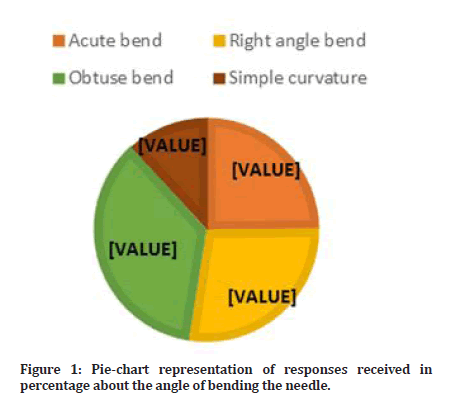
Figure 1: Pie-chart representation of responses received in percentage about the angle of bending the needle.
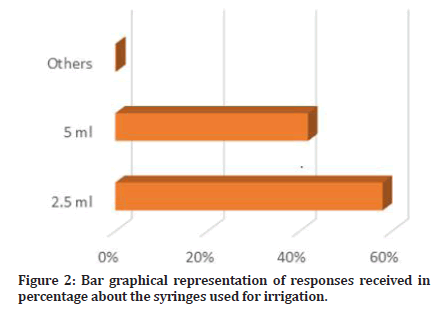
Figure 2: Bar graphical representation of responses received in percentage about the syringes used for irrigation.
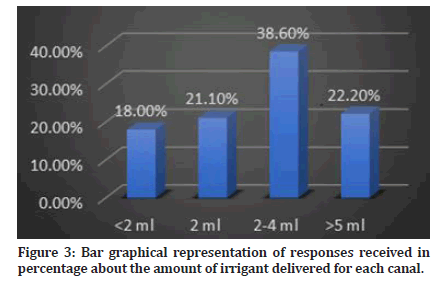
Figure 3: Bar graphical representation of responses received in percentage about the amount of irrigant delivered for each canal.
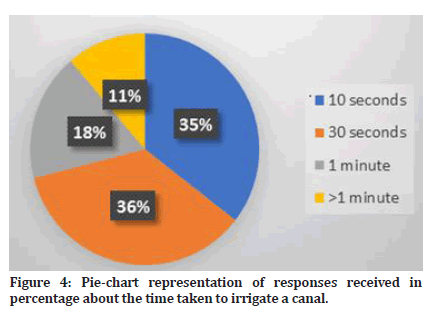
Figure 4: Pie-chart representation of responses received in percentage about the time taken to irrigate a canal.
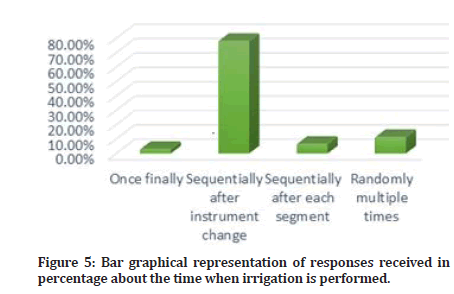
Figure 5: Bar graphical representation of responses received in percentage about the time when irrigation is performed.
Discussion
To the best of knowledge, there is very little evidence on cross-sectional survey done about irrigation protocols involving the general practitioners in India. The previously conducted surveys were restricted mainly to endodontists and postgraduates pursuing endodontics or to a specific geographic location but the current study employ comparison among all the three categories of professionals.
When assessed the usage of irrigants there is a statistically significant difference found between NaOCl usage among general practitioners and endodontic professionals. The usage of NaOCl irrigant was found to be higher among endodontic professionals than among general practitioners.
More than half of the participated endodontists and endodontic postgraduates had opted to use chlorhexidine for retreatment while exactly half of the general practitioners were found to prefer NaOCl and this difference was also found to be statistically significant(P<0.05). A randomized clinical trial comparing the outcome of endodontic retreatment using two root canal irrigants i.e., 1% NaOCl and 2% CHX concluded that no significant differences were found between the above-mentioned irrigants. The same study also concluded that microbial load during obturation as determined by qPCR also drastically altered the outcome [17].
About the angle of bending the needle, nearly onethird of the participating endodontists, endodontic postgraduates, and general practitioners were found to prefer90 degree or acute-angled bending of the needle only to be ideal. However, producing a sharp bend on the needle will jeopardize the flow of irrigants from within. A generalized lack of studies in this regard makes understanding the angulation of the needle bending concept difficult.
Through this study, it was quite clear that the rationale for using the conventional needle syringe method of irrigant delivery by the practitioners are mainly due to its simplicity, fast, cost-effectiveness, ease of availability. Also, a majority of the participants in this survey were found to use thicker gauge needles, the probable reason behind this could be attributed to lack of awareness and knowledge about the needle syringe usage and irrigant dynamics.
In a study by Gopi krishna et al. 47% of the participants use ultrasonic and 17% use manual dynamic agitations [16]. In another recent study, 39% were found to use combinations for performing agitation whereas 17% performs ultrasonic and 29% performs manual dynamic agitations [14]. The results obtained from previous studies may differ from the current study due to the participation of general practitioners. Regarding the choice of Irrigant based on pulpo-periapical status, the current study elicited a response from 89% participants who preferred to change the irrigant depending upon the status of pulp and periapex. The results obtained again were found to corroborate with that of other similar surveys mentioned earlier. This had clearly explained the adequacy of knowledge in preferring the irrigant based on the case selection.
About two-thirds of the participated endodontists and postgraduates were found to perform manual agitation whereas less than one-third only performs mechanized (sonic/ultrasonic) in their clinical practice. Comparatively, half of the general practitioners were found to perform only manual agitation in their practice and, the rest do not perform any agitation. Also, this difference of irrigant agitation usage between the three professionals was found to be statistically significant. The relatively less use of other activation devices during endodontic irrigation may be due to high cost and lack of exposure or awareness to the several available ones.
A recent review article published has enabled us to know that all the irrigating solutions possess a deleterious effect on the mechanical properties of endodontically treated teeth. Moreover, elevation in the concentration and exposure time of irrigants were further found to intensify the detrimental effects [18].
From a systematic review conducted, it can be inferred that all irrigation processes decreased the mechanical properties of root dentin, and especially EDTA was found to deplete the micro hardness to a very great extent irrespective of application time and volume of chelating agent [19]. Despite the deleterious effects of the irrigants on mechanical properties, the prime success of endodontic therapy lies in the disinfection of the canal.
The results obtained from this study hence necessitate the need for a standardized irrigation protocol to streamline its usage universally. Such a protocol should emphasize the concentration of irrigant, time of exposure, delivering agent and agitation methods to be performed, and so on.
For conventional needle syringe irrigation to be effectively carried out, the following principles must be adequately adhered to:
✓ A 5 ml syringe with a fine needle (preferably 30 gauges) should be preferred for its improved clinical advantages. ✓ When using a closed ended type of needle, it must be placed a distance of 0-1 mm short of the working length whereas an open-ended needle must be positioned at 2-3 mm short of working length. ✓ The root canal should be enlarged at least to size 30 with improved taper, to allow the irrigant flow up to working length [9].
The limitations of this cross-sectional survey are, majority of survey respondents fall within ten years of clinical experience, and also there was a lack of equal participation between general practitioners, postgraduates, and endodontists. This being a pan-India study, for the survey of this magnitude the participated sample size is comparatively less.
Conclusion
This survey concluded that knowledge and awareness about endodontic irrigation are sufficient, but the implementation of the same in clinical practice is comparatively less. Never the less, the dental practitioners must update themselves in view of recent advancements in this regard, and perform the irrigation procedures more meticulously.
Annexure 1
What type of Endodontic practice you do mostly?
a) Single Visit Endodontics b) Multiple visits
Which of these irrigants do you use primarily in your dental practice?
a) NaOCl b) EDTA c) CHX d) Others (MTAD, Saline)
Which according to you is the best irrigant for canal debridement?
a) NaOCl b) EDTA c) CHX d) Others (MTAD, Saline)
What is the concentration of NaOCl considered to be the gold standard for endodontic use?
a) 0.5-1.5%
b) 1.5-3%
c) 3-5.5%
d) More than 6%
Which of the following do you think is more crucial about NaOCl?
a) Concentration of NaOCl
b) Volume of NaOCl
c) None of above
d) Both of above
Have you ever warmed the NaOCl for its better efficiency?
a) Yes
b) No
c) CHX
d) Others
The concentration of Chlorhexidine to be used for Endodontic purpose is
a) 0.11-0.29%
b) 0.30-1.30%
c) 1.90-2.5%
d) More than 3%
The ideal concentration of EDTA to be used is
a) 11% and less
b) 15% and less
c) 17% and less
d) More than 18%
Do you alter the choice of irrigant depending upon the pulpo-periapical condition?
a) Yes
b) No
What is the irrigant of choice you prefer in Re-treatment cases?
a) NaOCl
b) EDTA
c) CHX
d) Other
Which of the following Irrigant delivery systems that you commonly use?
a) Conventional Needle/Syringe
b) Others (Pro rinse/Max-I probe)
According to you, retaining the Smear layer in Endodontic root canal is
a) Detrimental
b) Beneficial
If detrimental, which of the following best removes the smear layer?
a) EDTA
b) NaOCl
c) CHX
d) Others
Which again do you use to remove the smear layer in your practice?
a) EDTA
b) NaOCl
What is the ideal gauge of the needle preferred for endodontic irrigation?
a) 23 gauge
b) 25 gauge
c) 29 gauge
d) 30 gauge
Do you reproduce working length on to the syringe with rubber stop and irrigate?
a) Yes
b) No
Are you a regular user of side vented needle?
a) Yes
b) No
Are you aware of various irrigant activation systems that are present?
a) Yes
b) No
Which among the following irrigant activation methods do you use regularly in your dental practice?
a) Manual agitation with Gutta percha
b) LAI (Laser assisted irrigation)
c) Sonic (mechanized)
d) Others
Which among the following irrigant activation method sis best according to you?
a) Manual agitation with Gutta percha
b) LAI (Laser assisted irrigation)
c) Sonic (mechanized)
d) Others
How much amount of irrigant do you deliver for every single canal?
a) Less than 2 ml
b) 2 ml
c) 2-4 ml
d) More than 5ml
Which of the following syringes do you use for irrigation?
a) 2.5ml
b) 5ml
c) 20 ml
d) Others
On an average, how many times do you think you irrigate one canal?
a) Once Finally (After fully shaping and finishing)
b) Sequentially after every shaping and finishing i.e. After every instrument change
c) Sequentially after completion of each segment(Apicalthird/ Middle-third/Coronal-third)
d) Multiple times in a random manner
Have you ever noted the time you take to irrigate one canal?
a) Yes
b) No
How many seconds/minutes do you think you irrigate one canal?
a) 10 seconds per canal
b) 30 seconds per canal
c) 1 minute per canal
d) More than 1 minute per canal
What is the recommended angle of bending the needle for endodontic irrigation?
a) An Acute bend
b) A 90-degree bend
c) An Obtuse bend
d) A Simple curvature
What is the percentage of cases you adequately work with Rubber dam isolation?
a) More than 90% cases
b) More than 70% cases
c) 50-70% cases
d) Less than 50%
Do you regularly isolate using rubber dam in case you are working with Sodium Hypochlorite?
a) Yes
b) No
Have you encountered any Hypochlorite accident, if not adequately isolated with rubber dam?
a) Yes
b) No
References
- Coelho BS, Amaral RO, Leonardi DP, et al. Performance of three single instrument systems in the preparation of long oval canals. Brazilian Dent J 2016; 27:217-22.
- Peters OA, Schönenberger K, Laib A. Effects of four Ni–Ti preparation techniques on root canal geometry assessed by micro computed tomography. Int Endod J 2001; 34:221-30.
- Figini L, Lodi G, Gorni F, et al. Single versus multiple visits for endodontic treatment of permanent teeth: a Cochrane systematic review. J Endod 2008; 34:1041-7.
- Zehnder M. Root canal irrigants. J Endodontics 2006; 32:389-98.
- Haapasalo M, Shen Y, Qian W, et al. Irrigation in endodontics. Dent Clinics 2010; 54:291-312.
- Dutner J, Mines P, Anderson A. Irrigation trends among American Association of Endodontists members: a web-based survey. J Endodontics 2012; 38:37-40.
- Sheik R, Ranjan M. Assessment of knowledge about the effects of root canal irrigants among dental students. Int J Scientific Develop Res 2020; 5:169-176.
- Basrani B. Endodontic irrigation. Chemical Disinfection of the root canal system. Cham, Switzerland: Springer Int Pub AG 2015.
- Boutsioukis C, Lambrianidis T, Kastrinakis E, et al. Measurement of pressure and flow rates during irrigation of a root canal ex vivo with three endodontic needles. Int Endodontic J 2007; 40:504-13.
- Bronnec F, Bouillaguet S, Machtou P. Ex vivo assessment of irrigant penetration and renewal during the cleaning and shaping of root canals: a digital subtraction radiographic study. Int Endodontic J 2010; 43:275-82.
- Beus C, Safavi K, Stratton J, et al. Comparison of the effect of two endodontic irrigation protocols on the elimination of bacteria from root canal system: a prospective, randomized clinical trial. J Endodontics 2012; 38:1479-83.
- Boutsioukis C, Lambrianidis T, Verhaagen B, et al. The effect of needle-insertion depth on the irrigant flow in the root canal: evaluation using an unsteady computational fluid dynamics model. J Endodontics 2010; 36:1664-8.
- Natanasabapathy V, Durvasulu A, Krithikadatta J, et al. Current trends in the use of irrigant activation techniques among endodontists & post-graduate dental students in india-a knowledge, attitude and practice based survey. Europ Endodontic J 2020; 5:73.
- Nagendrababu V, Jayaraman J, Suresh A, et al. Effectiveness of ultrasonically activated irrigation on root canal disinfection: A systematic review of in vitro studies. Clinical oral Invest 2018; 22:655-70.
- Gopikrishna V, Pare S, Kumar AP, et al. Irrigation protocol among endodontic faculty and post-graduate students in dental colleges of India: A survey. J Conservative Dent: JCD 2013; 16:394.
- Zandi H, Petronijevic N, Mdala I, et al. Outcome of endodontic retreatment using 2 root canal irrigants and influence of infection on healing as determined by a molecular method: a randomized clinical trial. J Endodontics 2019; 45:1089-98.
- Dotto L, Onofre RS, Bacchi A, Pereira GK. Effect of root canal irrigants on the mechanical properties of endodontically treated teeth: a scoping review. J Endodontics 2020; 46:596-604.
- Tsenova-Ilieva I, Karova E. Effect of endodontic irrigants on root dentin microhardness: A systematic review. Matrix 2020; 15:17.
- Fedorowicz Z, Nasser M, Sequeira‐Byron P, et al. Irrigants for non‐surgical root canal treatment in mature permanent teeth. Cochrane Database Systematic Rev 2012.
Indexed at, Google Scholar, Cross Ref
Indexed at, Google Scholar, Cross Ref
Indexed at, Google Scholar, Cross Ref
Indexed at, Google Scholar, Cross Ref
Indexed at, Google Scholar, Cross Ref
Indexed at, Google Scholar, Cross Ref
Indexed at, Google Scholar, Cross Ref
Indexed at, Google Scholar, Cross Ref
Indexed at, Google Scholar, Cross Ref
Indexed at, Google Scholar, Cross Ref
Indexed at, Google Scholar, Cross Ref
Indexed at, Google Scholar, Cross Ref
Indexed at, Google Scholar, Cross Ref
Indexed at, Google Scholar, Cross Ref
Indexed at, Google Scholar, Cross Ref
Author Info
1Department of Conservative Dentistry and Endodontics, Chettinad Dental College and Research Institute, Kelambakkam, Kanchipuram, India
Citation: Srividhya Srinivasan, Sadasiva Kadandale, Anupama Ramachandran, Nyklesh Vijayakumar, Janani Karunakaran, Jwaalaa Rajkumar, Irrigation Protocols-Knowledge, Attitude and Practice among Dental Professionals in India: A Web-based Survey, J Res Med Dent Sci, 2022, 10 (4):84-90.
Received: 30-Mar-2022, Manuscript No. JRMDS-22-59032; , Pre QC No. JRMDS-22-59032 (PQ); Editor assigned: 01-Apr-2022, Pre QC No. JRMDS-22-59032 (PQ); Reviewed: 15-Apr-2022, QC No. JRMDS-22-59032; Revised: 20-Apr-2022, Manuscript No. JRMDS-22-59032 (R); Published: 27-Apr-2022
